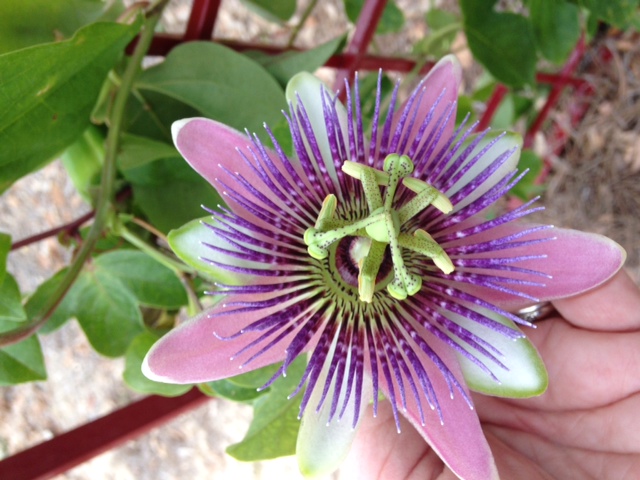
by Julie McConnell | Sep 2, 2014
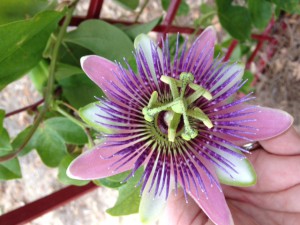
Purple passionflower
Gulf Fritillary caterpillars have a voracious appetite for purple passionflower vine Passiflora incarnata! This native vine is a host for the Gulf Fritillary Butterfly Agraulis vanilla larvae, is easy to grow, and readily available in garden centers.
Like any other vine, it grows quickly and may spread across your garden, so keep this in mind when choosing a location. It prefers full sun, is drought tolerant, adapts to many soil types, and should be given support for twining tendrils. Purple passionflower has intricate purple flowers that are followed by the fruit called a maypop, which is another common name for this vine.
Gulf fritillary butterflies are primarily orange with some black and white markings. They prefer sunny areas and adults will feed on nectar from many different flowering plants. However, they are more specific about where they will lay eggs because the diet of the caterpillar is more selective than adults.
If you have purple passionflower in your landscape, look for tiny yellow eggs and orange caterpillars with black spikes to see if you have a backyard Gulf fritillary nursery. Plants may be totally defoliated by the hungry caterpillars, but healthy plants can tolerate the damage and should flush back out without difficulty.
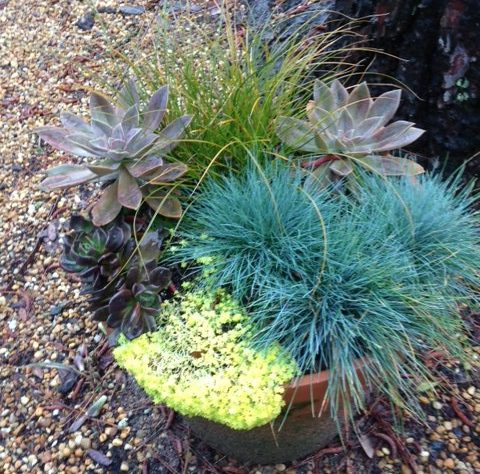
by Julie McConnell | Apr 1, 2014
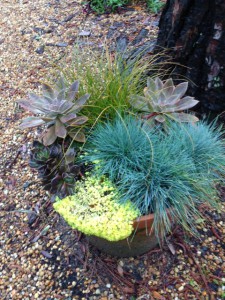
Container garden. Image: Julie McConnell, UF/IFAS
Living in a condo, apartment, or home with small yard does not mean you can’t garden at home. Whether you are interested in edible plants or ornamentals you can create a fit that is right for your space by using containers.
The first step in container gardening is the same as for traditional landscaping. First, asses your site to determine the cultural situation. Is it sunny or shady? Is water available from rainfall or from a nearby spigot? Will salt or wind be a factor? Are there height and width limitations? All of these need to be taken into consideration when you are planning to plant. These are elements that we have very little control over, so it is best to choose the right plants for the place you have.
Choose a container that will allow for adequate root growth and good drainage. If growing annuals, perennials, or small vegetables, a pot that is 12-18” deep should be sufficient. For shallow rooted or plants that like dry conditions you can go smaller. If plants grow tall make sure that the weight of the soil and pot is enough to keep it upright in gusty winds. It is not necessary to buy a container, you can reuse something as long as the water will drain and it is sturdy. Large containers may not need to be filled completely, but can be filled with a lightweight filler such as upside down nursery pots, water or soda bottles with lids, or packing peanuts. Choosing a light weight filler material makes the container easier to turn or relocate if needed and reduces the cost of potting soil.
Once you have determined site conditions, select the type of plants you would like to grow. When choosing edibles, the amount of sunlight available may be a limiting factor. Although some herbs and vegetables may benefit from a little bit of shade, they still need a bright location in order to produce well. If your site is very shady, consider shade loving ornamentals such as fern, hosta, and impatiens.
Understand the sunlight, water, and fertilizer needs of each plant. Group plants together that have similar requirements because they will receive the same care. Most herbs like a hot, dry situation and very little to no fertilizer. Grouping one of these herbs with a tomato plant that needs consistent watering and regular fertilizer will create a situation where one plant will perform poorly.
Container gardens require more care than plants in the ground because they dry out faster and may get no water from rainfall, if placed in a covered area. Consider using micro irrigation designed for containers or choose plants with low water needs such as the grasses and succulents.
To read more about container gardening read Container Gardening for Outdoor Spaces ENH1095.
The Foundation of the Gator Nation
An Equal Opportunity Institution
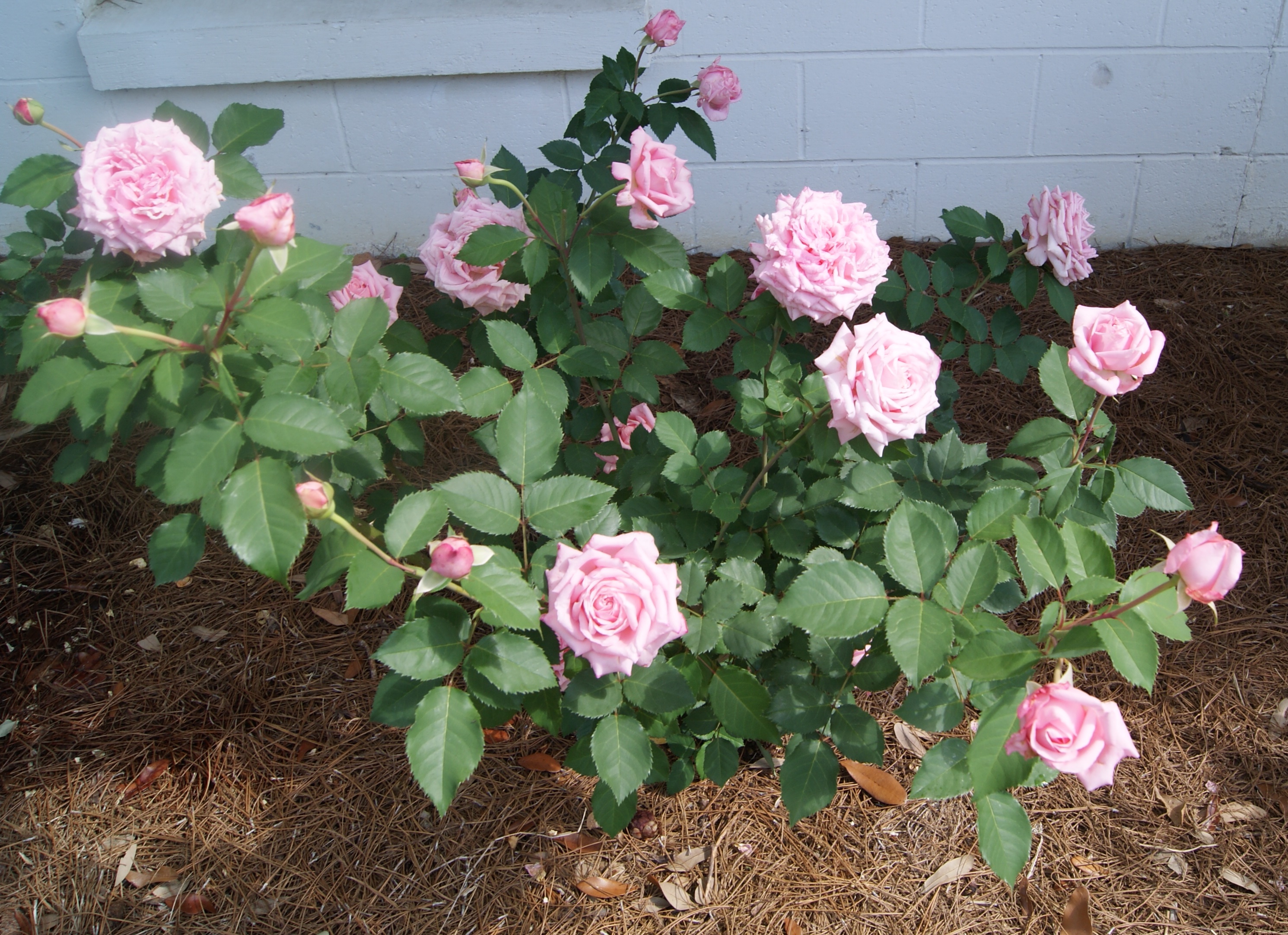
by Taylor Vandiver | Feb 25, 2014
Considering it is the month of Valentine’s, roses are an appropriate subject to discuss. Not bouquets couriered to various locations all over town, but bushes in the landscape that have been strategically neglected over the winter. Now their time has come; pull on the gloves and get to work.
February is the perfect time to prune rose bushes. Pruning is a step that is required to maintain healthy roses. When roses are pruned, new growth is promoted by removing dead, broken or diseased canes. Pruning also allows the gardener to give their plant an attractive shape and encourage flowering, which is ultimately the reason roses are planted!
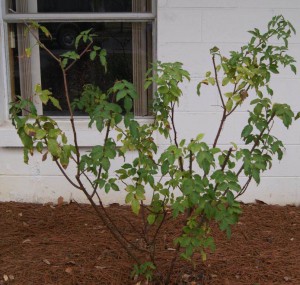
Belinda’s Dream rose before pruning. Image Credit Matthew Orwat
Deciding which roses to prune will depend on their class. Hybrid tea, grandiflora and floribunda roses are repeat bloomers and need a moderate to heavy annual pruning this time of year. Some old-fashioned roses and climbers that bloom only once a year should be treated differently and pruned immediately after flowering. They set their buds on old wood from the previous year’s growth; therefore, pruning them would remove most of this year’s blooms. An exception to this would be dead, diseased or damaged wood on any rose bush or canes that are crossing and rubbing. This should be removed immediately upon notice.
There are certain techniques that should be used when pruning any type of rose, no matter the time of year. Any pruning shear, saw or lopper you use should be sharp and sterile. Always wear protective gloves when dealing with roses, unless you don’t mind coming back bloody and mangled.
[warning]
Crown gall and canker can be spread between gardens and individual plants by dirty shears. To prevent the spread of disease, always disinfect pruning shears when beginning to prune with a 5-10% bleach or 20% rubbing alcohol solution, especiallly if they have been used in any other garden. If crown gall or canker has been found in one’s own garden, shears should be disinfected between each plant, no exception. This should also occur when bringing new plants into the garden, until they have been observed to be disease free.
[/warning]
The first step when pruning any rose is to remove dead, damaged or weak stems leaving only the most vigorous, healthy canes. Try to cut the stems one inch below darkened areas, making sure to cut back to green wood. Always make your cut at a 45-degree angle; this will keep water from sitting on top of a stem and causing rot. When pruning try to open up the center of the rose bush. Pruning like this will increase air circulation and help prevent diseases.
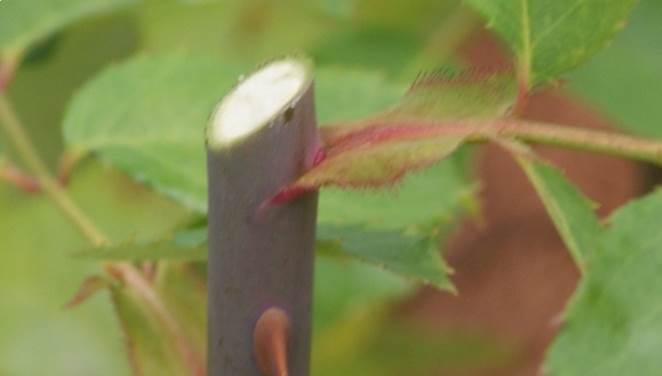
Pruning Cut on Belinda’s Dream rose. Image Credit Matthew Orwat
Since roses send out new growth from the bud just below a pruning cut, try to make pruning cuts above a leaf bud facing out from the center of the plant. Make your cut about ¼ inch above the bud and at the same angle as the bud. If any rubbing or crossing branches are noticed, the weakest of those branches should be removed.
Deadheading, or removing spent flowers, can also be done at this time of year. When deadheading, remove the flower by making a cut just above the next five or seven-leaf branch down on the stem. This will allow for a strong and healthy cane to grow in its place. If no live buds remain, remove the entire cane.
Modern reblooming roses (hybrid teas, floribundas, and grandifloras) should be pruned just as the buds begin to swell, which is around mid to late February. When practicing hard pruning, try to leave about four to eight large, healthy canes the diameter of your finger or larger on the shrub. For a more moderate approach, prune shrubs as discussed earlier and cut them back to about 12 to 24 inches from ground level. Generally, any cane thinner than a pencil should be removed.
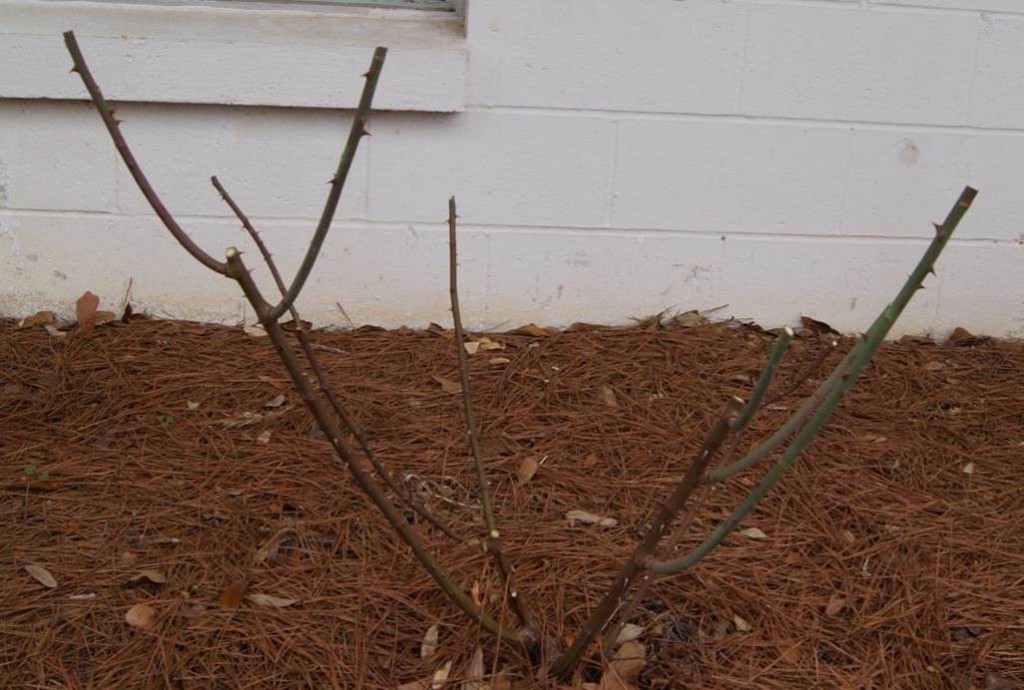
Belinda’s Dream rose after pruning. Image Credit Matthew Orwat
Don’t worry about pruning recently purchased new roses. Newly purchased roses have most likely been pruned, and no further cutting is necessary. Hopefully with the help of this article you can make a date to spend some quality time with your roses this season. The price of neglect is overgrown roses that are not nearly as attractive.
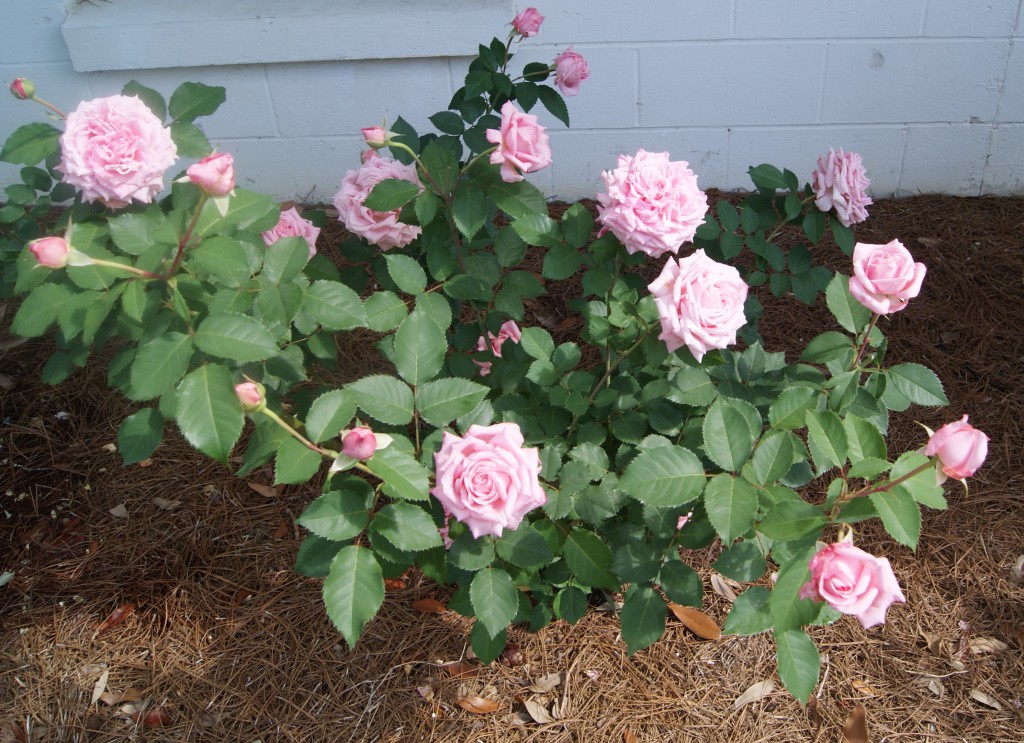
First flush of properly pruned Belinda’s Dream shrub rose. Image credit Matthew Orwat
Article written by Taylor Vandiver with additional content about sanitation by Matthew Orwat
by Julie McConnell | Nov 18, 2013

Delphiniums
As the weather changes, so should your flower bed. Annual flowers provide fantastic color to landscapes with months of flowers or attractive foliage, but the trade-off is that they give you all they’ve got over one growing season.
There are two main groups of annuals, summer (warm season) and winter (cool season). Summer annuals are considered “tender” and will not tolerate frosts, but winter annuals are “hardy” meaning they can stand cool temperatures and even hard frost if given time to establish before the coldest weather arrives. Most winter annuals actually prefer cooler temperatures and perform poorly during the hottest part of the year.
Some hardy winter annuals that can be planted after October are pansies, violas, snapdragons, dianthus,delphinium, petunia, alyssum, dusty miller, hollyhock, ornamental cabbage and kale, and verbena. With all the choices available, winter flower beds can be filled with all ranges of the color palate!
Plan to change flower beds to winter annuals from October to November, depending on the weather. Wait until cool weather trends arrive so that the new plants are not stressed by hot weather and high humidity. Most winter annuals will perform well until warm weather arrives, typically April or May in North Florida. Read more about “Gardening with Annuals in Florida.”
by Beth Bolles | Aug 5, 2013
Thinking of bulbs for the garden? Summer is not necessarily the time of year that gardeners think about beautiful blooms from bulbs and bulb-like plants, but there are many that bloom in the summer garden.
In general, many types of plants with an underground storage organ are classified as a bulb. These include plants with tubers, rhizomes, or corms. True bulbs including Lycoris and Crinum lily are compressed stems with a growing point surrounded by thick, fleshy scales. Corms such as Crocosmia are solid masses of stem tissue with a terminal bud and side nodes. The rhizome is an underground stem that grows laterally, with representatives of this type being blackberry lily and ginger.
It is likely that your garden is full of bulb-like plants and you were just not aware of their underground beginnings. If you want to consider a few more for the summer garden, here are some good choices.
Blackberry lily is a member of the Iris family that offers good summer bloom in our northern Florida gardens. Plants form sprays of foliage about 2 feet in height with stalks of orange flowers with red spots. Plant in full sun or partial shade and supply with well drained, amended soil.
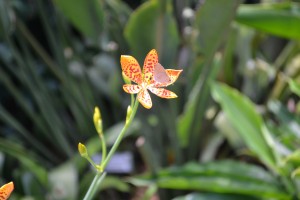
A hairstreak butterfly visits the Blackberry lily flower.
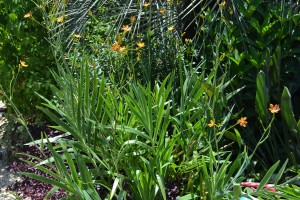
Another bright summertime bloomer is Croscomia. Commonly overlooked early in the year as foliage regrows from the cold, the bright orange flowers that emerge in summer make it a feature in garden beds. Plants grow well in both full sun and partial shade but clumps can expand easily beyond the desirable planting area. Thin out every few seasons to keep the clump manageable.
A tuberous perennial that will have stunning flowers closer to eye level is the Gloriosa or flame lily. Plant stems will wind around a trellis or garden feature, hold on with tendrils, and support large upward-curved petals. Flower colors are red, yellow, orange, or mixes of several colors. Flame lily prefers sunny locations and lots of moisture in the growing season. Winter soils should be drier to prevent tubers from rotting.

Flame lily growing with a spring blooming vine.
All of these options can enhance your garden and extend your bulb growing season beyond the spring. Happy Gardening!













